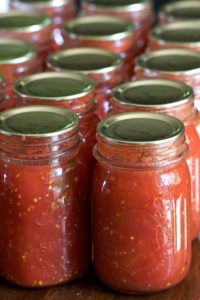Preserving Fruits & Vegetables
go.ncsu.edu/readext?709476
en Español / em Português
El inglés es el idioma de control de esta página. En la medida en que haya algún conflicto entre la traducción al inglés y la traducción, el inglés prevalece.
Al hacer clic en el enlace de traducción se activa un servicio de traducción gratuito para convertir la página al español. Al igual que con cualquier traducción por Internet, la conversión no es sensible al contexto y puede que no traduzca el texto en su significado original. NC State Extension no garantiza la exactitud del texto traducido. Por favor, tenga en cuenta que algunas aplicaciones y/o servicios pueden no funcionar como se espera cuando se traducen.
Português
Inglês é o idioma de controle desta página. Na medida que haja algum conflito entre o texto original em Inglês e a tradução, o Inglês prevalece.
Ao clicar no link de tradução, um serviço gratuito de tradução será ativado para converter a página para o Português. Como em qualquer tradução pela internet, a conversão não é sensivel ao contexto e pode não ocorrer a tradução para o significado orginal. O serviço de Extensão da Carolina do Norte (NC State Extension) não garante a exatidão do texto traduzido. Por favor, observe que algumas funções ou serviços podem não funcionar como esperado após a tradução.
English
English is the controlling language of this page. To the extent there is any conflict between the English text and the translation, English controls.
Clicking on the translation link activates a free translation service to convert the page to Spanish. As with any Internet translation, the conversion is not context-sensitive and may not translate the text to its original meaning. NC State Extension does not guarantee the accuracy of the translated text. Please note that some applications and/or services may not function as expected when translated.
Collapse ▲Preserving fruits and vegetables is a great way to save money and provide healthy food for your family. If you have grown a large garden this season you may have already been preserving that goodness to enjoy over the winter. If you may not have a large garden, then you can visit a local Farmer’s Market or produce stand to purchase fruits & vegetables to preserve.
My two favorites to preserve are peaches which I freeze and homemade Picante sauce that I can using homegrown tomatoes and jalapeno peppers.
The USDA Complete Guide to Home Canning is available to download free or you can purchase a hard copy. The book has sections to make it easier to download. Topics covered include principles of home canning, tools and equipment needed, and proper techniques and practices to ensure the food you preserve is safe to eat.
There are sections on fruit, tomatoes, vegetables, meats, fermented food, pickled vegetables, and jams and jellies. Excellent recipes are included that cover just about anything you can think of – apple sauce, pie fillings, salsa, succotash, chili, sauerkraut, all sorts of pickles and pickled vegetables, and of course jams and jellies.
Food preservation is not hard. If you can read and follow written directions, then you can do it! Turn it into a family activity. Research has shown that kids who help prepare food at home are more likely to make healthy food choices. This is a good way to get your children or grandchildren involved and to eat healthily. Let the kids help in the selection and preparation of the fruit or vegetable to be preserved. You will certainly create wonderful memories and set your kids on a path to enjoying preserving their own food and healthier eating.





